The Amazing Story of Smoky, The Cutest WWII Hero in the Philippines
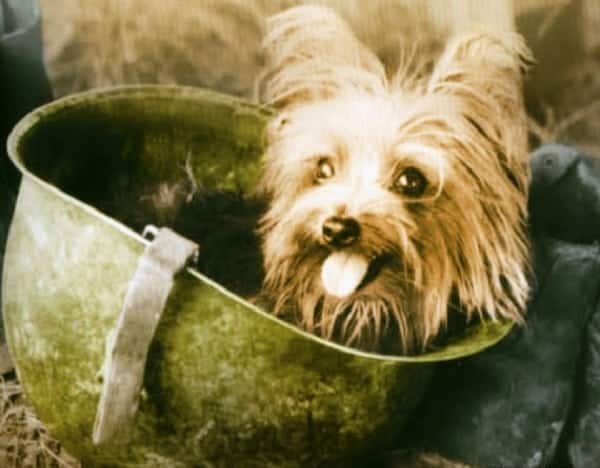
Weighing only four pounds and standing seven inches tall, Smoky is just a toy dog by today’s standards. Surprisingly, this legendary Yorkshire Terrier turned out to be one of the most decorated WWII canine heroes.
This is her incredible story.
Also Read: The WWII Japanese Soldier Who Hid in Philippine Jungle For 29 Years
A Perfect Match.
In 1944, Cleveland native Bill Wynne was stationed with the U.S. Army Air Corps in Nadzab, New Guinea. One day, his tent mate recovered a small, scrawny dog from an abandoned foxhole on the side of the road. The dog–whose breed was relatively unknown at that time–was tied to a truck tire and appeared to be wet and sick.
Growing up a dog person, Bill couldn’t resist the little animal who excitedly jumped up and down at the sight of him. In the end, he bought the dog from the soldier for two Australian pounds ($6.44 U.S.). He then shortened the dog’s name from the original “Smokums” into “Smoky”–in reference to its gray and brown fur which reminded Bill of Cleveland’s industrial smoke.
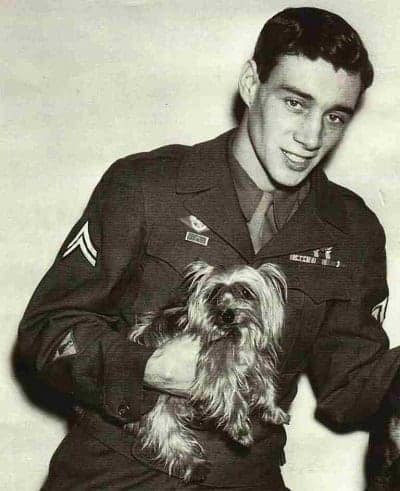
Together, they survived typhoons, limited food supply, and fatal diseases such as malaria during their numerous combat missions.
More than a companion, Smoky learned a lot of tricks to please her master. And then came one of the highlights in Smoky’s career: She was named the best mascot in the Southwest Pacific by Yank Down Under Magazine on July 14, 1944. In the said magazine, she was photographed in her now-iconic pose: sitting in Bill’s WWII helmet.
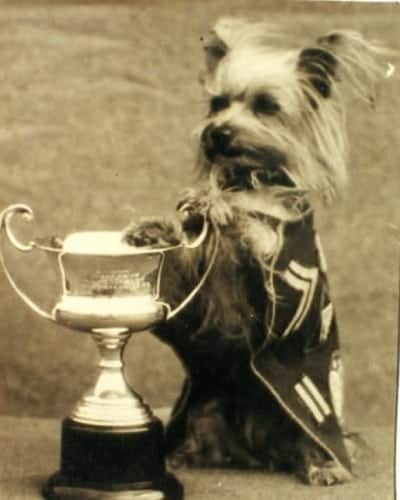
World’s First Therapy Dog.
Adorable, eager to please her owner, and receptive to new tricks, Smoky began her pioneering work as a therapy dog at the 233rd Station Hospital in New Guinea. Bill was then staying at this hospital after being diagnosed with dengue fever.
Amused by the dog, the nurses brought Smoky with them during patient rounds, lightening up the mood of several soldiers wounded in the Biak Island invasion.
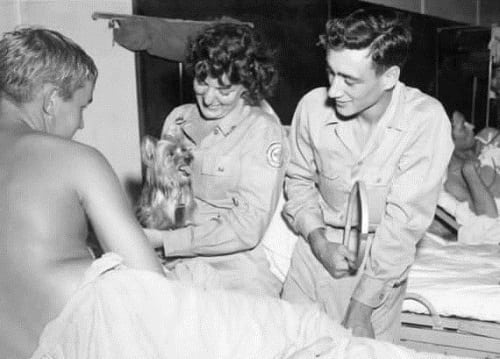
After being granted two weeks’ recuperative leave in Australia, Bill and Smoky visited two military hospitals in Brisbane. There, Smoky performed different tricks–from riding a scooter to walking a tightrope while blindfolded. Smoky once again showed her charm effortlessly, much to the delight of sick and wounded soldiers.
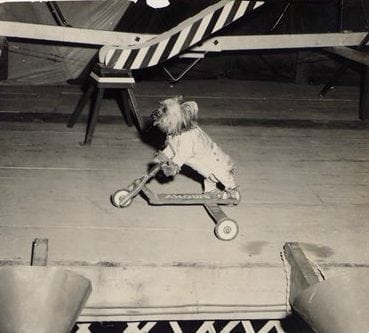
“There’s a complete change when we came into the room,” said Bill in an interview. “They all smiled; they all loved her.”
Nonetheless, Smoky’s 12-year career as a therapy dog pales in comparison to her other role which she has been best known for: a WWII dog hero.
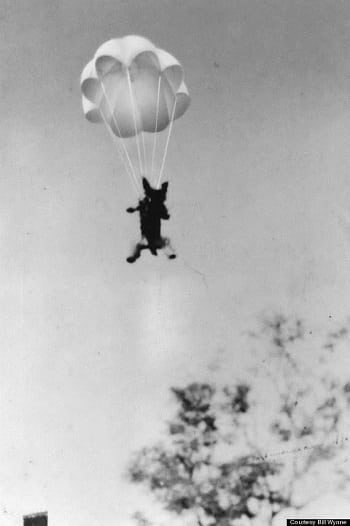
A Heroine in the Philippines.
In January of 1945, Bill Wynne–then a 22-year old aerial photographer in the Army Air Forces 26th Photo Recon Squadron–landed at Lingayen Gulf in Luzon, along with the rest of the American forces.
Bringing Smoky ashore was very challenging yet Bill pulled it off, thanks to the dog’s diminutive size. According to his accounts, he “carried my barracks bag on one shoulder, my rolled-up cot on my other shoulder and my rifle in my hands. Smoky sat on the cot.”
In my email correspondence with Bill, he shared specific details of their arrival in the Philippines:
“We waded ashore from LST 706 at Lingayen Gulf at 3:00am Jan.12, ’45. Smoky and I hid among the palm trees near the beach until dawn when the main part of our 26th Photo Recon Sq disembarked from LTS 729 and we were taken through Dagupan by trucks and on to Lingayen where we set up in homes of natives temporarily then set up tents between the homes. The U.S. Army rented the homes.
Recommended Article: 10 Biggest Misconceptions About World War II In The Philippines
On arrival we found the people were starving as Japanese periodically raided the villages taking all the food they could gather. We shared our 30 day supply of food we brought with us for 350 men. Our Sq. hired 45 Filipinos to do building around the area and our men had additional house boys cleaning up our tents so we could get American Pesos into their hands. At that time Japanese Invasion money became worthless.”
Their stay in the Philippines was very tough indeed. Japanese attacks on the Allied airfield at Lingayen Gulf was always a possibility, and the need to establish strong communication lines was imperative.
The initial plan was to run communication wires through a 70-foot culvert (an underground pipe designed to drain water from above) from the base to the three squadrons. The design would enable Wynne’s photo-reconnaissance unit to contact the headquarters if they needed reinforcements.
But here’s the problem: they lacked the equipment and a safe environment to complete such a task. Their combat engineers had recently moved to Baguio, bringing all their equipment with them. They could manually install the telephone lines by digging a trench, but doing so would be time-consuming and would also expose their men as well as their 40 warplanes (which had to be moved from the sheltered area) to the enemy attacks.
Sgt. Bob Gapp had an idea. He suggested that given Smoky’s small size (the dog was 7-inch tall, while the culvert was 8 inches in diameter), she could be the best choice to do the job. So Bill tied a kite string to Smoky’s collar, hoping that she would pull a feeder line under the airfield. He then left the dog with Gapp, moved to the other end of the culvert, and coaxed Smoky towards the pipe.
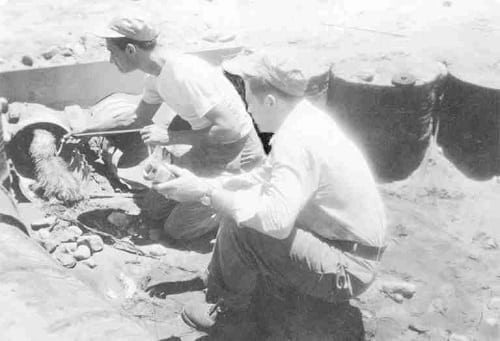
The pipe was very narrow and with sand piling up between each 4-foot section, Smoky had a very high risk of getting trapped.
But trust between Bill and his furry friend prevailed: Smoky hesitated at first, but she kept moving forward in search of her master. Bill finally breathed a sigh of relief when Smoky reached the finish line and jumped straight to his arms. The communication wires were established while Smoky, as a reward for her heroic effort, got a steak for dinner.
Smoky, the dog who was almost abandoned in the middle of the jungle, completed in two minutes a vital task that was supposed to be done by 70 men in 3 days. And she did it all because she was asked to.
After the war, Bill and Smoky continued their tour of different hospitals to cheer up sick, wounded, and lonely patients. Bill then briefly worked as a dog trainer in Hollywood before being hired by the National Advisory Committee for Aeronautics (NACA) as a flight photographer.
Smoky retired in 1955 and peacefully died in her sleep on February 21, 1957, at the age of 14.
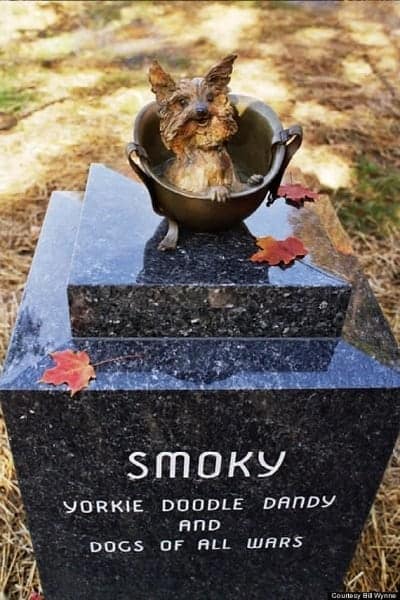
Interesting facts:
- As of this writing, Smoky has a total of 6 memorials in the U.S. and another 3 in Australia.
- Smoky was credited for popularizing Yorkshire Terriers. In fact, Joan Gordon, a breed historian for the Yorkshire Terrier Club of America, said that “Smoky was the dog that brought an unexpected interest to the then-obscure Yorkshire Terrier breed with news stories from the far Pacific Theatre in 1945.”
- Smoky’s incredible story has been told in more than 50 books. The Animal Planet also produced two episodes about her life.
- Bill Wynne wrote a book about the life and heroism of Smoky. His work, entitled “Yorkie Doodle Dandy,” was released in 1996. Best-selling novelist Amy Tan considers it as her favorite dog book.
- A bronze statue showing Smoky nestled in Wynne’s WWII helmet can be found in the Rocky River Reservation, just south of the Detroit Avenue Bridge on Valley Parkway. Installed during Veterans Day 2005, this serves as a memorial to Smoky and “dogs of all wars.”
References
Frankel, R. (2014). Dogs at War: Smoky, a Healing Presence for Wounded WWII Soldiers. National Geographic. Retrieved 11 May 2015, from http://goo.gl/SFjqNs
Jedick, P. (2007). Smoky The Wonder Dog. Cleveland Magazine. Retrieved from http://goo.gl/XTD6pj
Smoky War Dog,. Smoky. Retrieved 11 May 2015, from http://goo.gl/2JUJ1J
The Huffington Post,. (2013). Smoky The Yorkshire Terrier Was Probably The Cutest Service Member In WWII. Retrieved 11 May 2015, from http://goo.gl/ffyMOK
Written by FilipiKnow
FilipiKnow
FilipiKnow strives to ensure each article published on this website is as accurate and reliable as possible. We invite you, our reader, to take part in our mission to provide free, high-quality information for every Juan. If you think this article needs improvement, or if you have suggestions on how we can better achieve our goals, let us know by sending a message to admin at filipiknow dot net
Copyright Notice
All materials contained on this site are protected by the Republic of the Philippines copyright law and may not be reproduced, distributed, transmitted, displayed, published, or broadcast without the prior written permission of filipiknow.net or in the case of third party materials, the owner of that content. You may not alter or remove any trademark, copyright, or other notice from copies of the content. Be warned that we have already reported and helped terminate several websites and YouTube channels for blatantly stealing our content. If you wish to use filipiknow.net content for commercial purposes, such as for content syndication, etc., please contact us at legal(at)filipiknow(dot)net